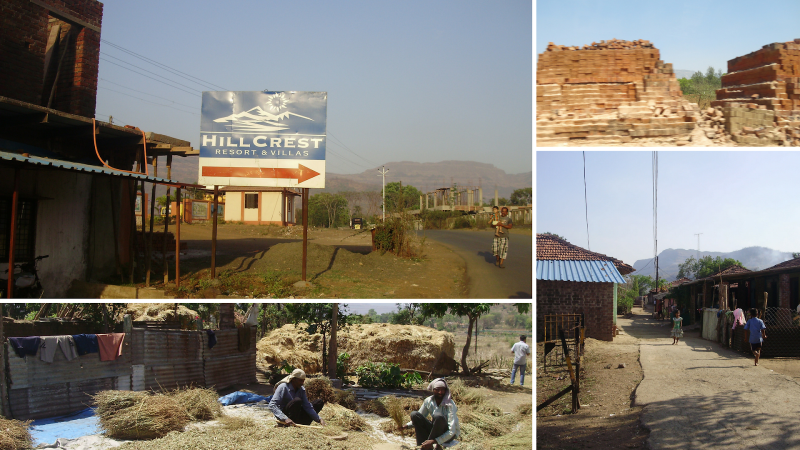
Urban-rural transition zones are a breeding ground for unexpected changes in resources and livelihood, shows study from IIT Bombay.
Increasing demand for space in cities are forcing people to move to surrounding rural regions, which are more affordable. These areas, called peri-urban regions, have a mix of rural and urban elements. In a study, researchers from the Indian Institute of Technology Bombay (IIT Bombay) have observed that the natural resources were stressed and livelihoods changed to non-agricultural means in the peri-urban regions around Mumbai.
Developing peri-urban regions without proper planning can bring trouble since vast agricultural areas are modified to suit urban needs. They differ from urban sprawls that are unplanned, scattered expansion of urban residential areas, in that peri-urban regions still maintain rural components like open land and farming. In this process, natural resources like water are abused, primary occupations of locals undergo change, and ecosystems are damaged. “It is high time that peri-urbanisation in India is studied from the vantage point of the peri-urban regions, and not as an extended issue of urban management challenges”, says Prof. T.I. Eldho from the Civil Engineering Department, who led the study.
The researchers of the study focused on four peripheral villages of Greater Mumbai-- Mangaon Tarf Wasare, Mulgaon Tarf Wasare, Kondhane and Salpe of the Karjat sub-district. They used census reports for the years 2001 and 2011, surveyed 40 respondents with specifically designed questionnaire, and conducted group discussions with village heads to understand the demographic and livelihood details, and land and water usage.
The study found that agriculture, which was a main livelihood occupation, nose-dived from 20% in 2001 to 9% in 2011. It was now perceived as a marginal occupation as agricultural lands were now in the hands of private players, unlike land acquisition by the state. This also impacted farmers who cultivated their own land or tilled others’ lands. They now work as informal labourers at brick kilns or engage in small scale sand mining in the riverbed. . What was once their farms, had now turned into farmhouses, event venues and weekend getaways for the rich.
Brick kilns, often illegal, have now cropped up in large numbers. The study found that in addition to acting as an informal employer, the brick kilns now supply raw material to the growing construction in these areas. In the process, they pollute the environment, demand a constant supply of water and place a considerable strain on other natural resources in the peri-urban regions.
Acute shortage of water is another growing concern in the four peri-urban areas, the study found. Despite receiving an average annual rainfall of 3691 mm, thrice the national average, these villages faced chronic water shortage right after monsoon. Individual borewells, dug up in farmhouses and resorts, for their upkeep and to water orchard crops like mango, has resulted in depleting groundwater. Open wells, which once used to be the main source of water for the locals, including tribals, have all dried up. This has led to informal groundwater markets in the villages. Dams and water diversions that are planned, cater only to the urban needs, worsening the situation.
So, can’t these villages stand for themselves? “The existing local self-governments are weak, statutory bodies that are brutally set aside in times of actual decision making”, remarks Prof. Eldho, who believes that these peri-urban regions are not ‘passive recipients’ of the ‘development’ forced down their throats. “There is a strong agency at work here”, he says. The fact that these peri-urban zones lie outside the administrative boundaries of the urban city, often administrative confusions could lead to blame games. We can only make a difference when these dynamics are well-understood.
With our cities expanding at a rapid pace, peri-urbanisation of the bordering villages are here to stay. However, we can manage this process better, say the authors, who push for approaches away from conventional urban-centric policies. “The major pitfall of urban-centric policies is just that; they tend to implicitly assume that all peri-urban regions can be better governed through better management of urban concerns and better urban space planning”, opines Prof. Eldho. “We need long-term, interactive and decentralised mechanisms that help decrease the power differentials between these villages and the urban core”, he adds.
The Government of India has sought to address the concerns of peri-urbanisation with its National Rurban Mission. But Prof. Eldho is cautiously optimistic. “It is a step in the right direction if implemented with strong decentralization and participatory governance mechanisms, especially with regard to natural resource management”, he says.
The cities will continue to expand and we will continue to see the changes. However, we are better off not getting lost in this transition.






